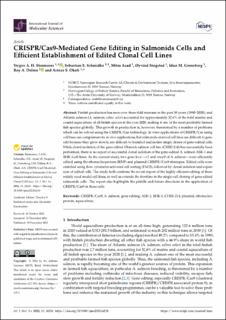| dc.contributor.author | Strømsnes, Trygve | |
| dc.contributor.author | Schmidke, Sebastian | |
| dc.contributor.author | Azad, Mitra | |
| dc.contributor.author | Singstad, Øyvind | |
| dc.contributor.author | Grønsberg / Mikkelsen, Idun Merete | |
| dc.contributor.author | Dalmo, Roy Ambli | |
| dc.contributor.author | Okoli, Arinze Stanley | |
| dc.date.accessioned | 2023-01-05T09:44:02Z | |
| dc.date.available | 2023-01-05T09:44:02Z | |
| dc.date.created | 2022-12-20T10:55:56Z | |
| dc.date.issued | 2022 | |
| dc.identifier.citation | International Journal of Molecular Sciences. 2022, 23 (24), . | en_US |
| dc.identifier.issn | 1661-6596 | |
| dc.identifier.uri | https://hdl.handle.net/11250/3041132 | |
| dc.description.abstract | Finfish production has seen over three-fold increase in the past 30 years (1990–2020), and Atlantic salmon (A. salmon; salmo salar) accounted for approximately 32.6% of the total marine and coastal aquaculture of all finfish species in the year 2020, making it one of the most profitable farmed fish species globally. This growth in production is, however, threatened by a number of problems which can be solved using the CRISPR/Cas technology. In vitro applications of CRISPR/Cas using cell lines can complement its in vivo applications, but salmonids-derived cell lines are difficult to gene edit because they grow slowly, are difficult to transfect and isolate single clones of gene-edited cells. While clonal isolation of the gene-edited Chinook salmon cell line (CHSE-214) has successfully been performed, there is no report of successful clonal isolation of the gene-edited A. salmon ASK-1 and SHK-1cell lines. In the current study, two gene loci—cr2 and mmp9 of A. salmon—were efficiently edited using the ribonucleoprotein (RNP) and plasmid CRISPR/Cas9 strategies. Edited cells were enriched using flow cytometer-activated cell sorting (FACS), followed by clonal isolation and expansion of edited cells. The study both confirms the recent report of the highly efficient editing of these widely used model cell lines, as well as extends the frontline in the single-cell cloning of gene-edited salmonids cells. The report also highlights the pitfalls and future directions in the application of CRISPR/Cas9 in these cells. | en_US |
| dc.description.abstract | CRISPR/Cas9-Mediated Gene Editing in Salmonids Cells and Efficient Establishment of Edited Clonal Cell Lines | en_US |
| dc.language.iso | eng | en_US |
| dc.rights | Navngivelse 4.0 Internasjonal | * |
| dc.rights.uri | http://creativecommons.org/licenses/by/4.0/deed.no | * |
| dc.title | CRISPR/Cas9-Mediated Gene Editing in Salmonids Cells and Efficient Establishment of Edited Clonal Cell Lines | en_US |
| dc.title.alternative | CRISPR/Cas9-Mediated Gene Editing in Salmonids Cells and Efficient Establishment of Edited Clonal Cell Lines | en_US |
| dc.type | Journal article | en_US |
| dc.type | Peer reviewed | en_US |
| dc.rights.holder | 2022 by the authors | en_US |
| dc.description.version | publishedVersion | en_US |
| cristin.ispublished | true | |
| cristin.fulltext | original | |
| cristin.qualitycode | 1 | |
| dc.identifier.doi | 10.3390/ijms232416218 | |
| dc.identifier.cristin | 2095590 | |
| dc.source.journal | International Journal of Molecular Sciences | en_US |
| dc.source.volume | 23 | en_US |
| dc.source.issue | 24 | en_US |
| dc.source.pagenumber | 17 | en_US |

